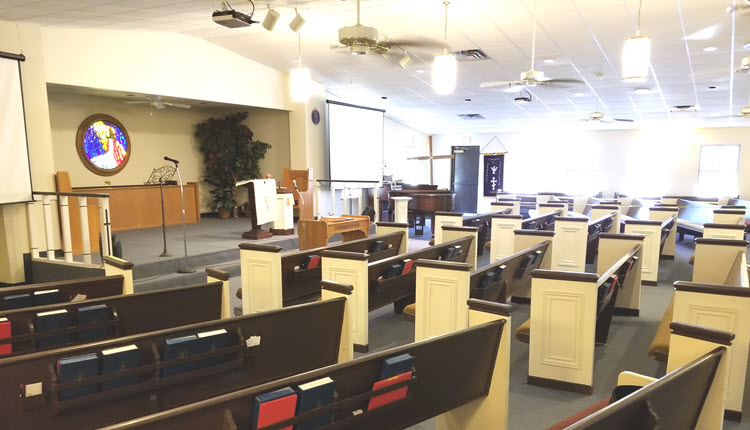The decline of American Christianity has long been the most popular topic at So What Faith. As the pandemic continues, the significance of the decline becomes more apparent both at the macro level and in the lives of individual congregations.

Trend 1: Declining Membership in Congregations
One data point has received greater consideration this year than any year since I’ve been a part of the conversation about the decline of American Christianity: church membership. A Gallup article published in March generated this renewed interest: U.S. Church Membership Falls Below Majority for First Time.
According to Gallup’s survey, somewhere between 69% and 76% of the American population answered affirmatively the question “Do you happen to be a member of a church, synagogue, or mosque” from 1940-2000. Since the year 2000, the percentage has steadily declined from 70% in 2000 to 49% in 2020. In explaining the shift, the author notes two significant components – both of which area true in all generational cohorts – (1) more people choosing religious non-affiliated and (2) more people with a religious affiliation who do not hold membership in a church, synagogue or mosque.
While much has been written to add additional layers to this complex story, the overall trend is clear: fewer Americans are members of congregations.
Some examples of decline within specific denominations:
- United Church of Christ Decline Enters 7th Decade (2020)
- Presbyterian Decline: The First 35 Years of the PCUSA (2020)
- Another Decade of Major Decline in the Episcopal Church (2019)
Trend 2: Church Closures Outnumbering New Church Starts
Another key concern is the viability of individual houses of worship. In recent years, the percentage of congregations that are quite small has increased significantly. Since there is no shared reporting among all Protestant denominations much less all Christian congregations, it is impossible to know exactly how many churches close in any given year. While the number of 10,000 churches closing a year is widely used, experts suggest the pre-pandemic reality was likely somewhere between 1% and 2% of all congregations or 3,850 to 7,700.
Lifeway Research published the findings in May from their research that sought to better understand just how many Protestant churches are opening and how many are closing in any given year. For the 34 denominations included in their study, around 4,500 closed in 2019 while around 3,000 new congregations started. For perspective, the sample size of these congregations is around 60% of all Protestants in America. Using simple math to enlarge this to all Protestants (assuming similar rates of closure) there were 7,500 closures in 2019 – or a number near the upper range of previous research.
Given the economic challenges faced by the smallest congregations during the pandemic, it seems reasonable to assume the number of closures in 2020 and 2021 will greatly exceed those in 2019. And, given the pandemic’s challenges to conducting worship and other in person activities, it seems reasonable to assume that new churches opening for 2020 and 2021 will decline thereby widening the gap.
The trend is clearly toward fewer Christian congregations.
Some further information on
- Are 10,000 Churches Closing Every Year? (2020)
- The Coming Wave of Permanent Church Closures (2020)
- Central Christian Church: Concluding 158 Years (2021)
Trend 3: Religious Giving is Declining
Charitable giving for the year 2020 increased 5% from the prior year according the Giving USA 2021 report, which was published in June. Lily Family School of Philanthropy’s David L. King placed current year change in religious giving in context noting it increased by just 1% – far less than the overall net gain. And, he reminded readers that while religious giving remains the largest category at 28% of all philanthropic giving this year’s decreased portion of the overall pie is a continuation of a decades long drop. (For more on the longer-term shift away from religious giving check out Less Religious Charitable Giving).
The long-term trend continues: a smaller and smaller percentage of philanthropic giving is being directed to religious causes.
Trend 4: Congregational Giving is Declining
Early in the pandemic, many surveys showed that giving to congregations had declined considerably. As the pandemic progressed and as more churches reopened for some in person services and other programming the numbers began improving.
In December 2020, the United Church of Christ conducted a survey of clergy to learn how the pandemic was impacting congregational giving. The survey found that only 19.8% saw an increase in giving while 38.6% had relative stability in giving and 41.7% experienced a decline in giving. Put differently, congregations were more than twice as likely to experience a decline in giving compared to an increase in giving.
Compared to the other trends, this one is the least clear. With fewer people belonging to congregations and with those who belong participating less frequently, it seems likely that total dollars given at the congregational level will continue to decline.
So What?
Christian congregations are learning new ways to be the church. The pandemic has done more to accelerate changes already happening than to require changes not previously considered by congregations.
The four trends explored in this blog post have the greatest impact at the denominational or network level. Those structures have been learning to do more with less for decades. And, now, they are resourcing congregations to behave in a similar manner.
While the focus here is on overall trends, it is important to note that many individual congregations are thriving!
- How have declines in membership and giving impacted your congregation? the faith communities in your town, city or metropolitan area?
- What is one lesson your congregation has learned or one change your congregation has implemented during the COVID-19 pandemic that will likely yield positive results for years to come?
- Has your congregation taken steps to intentionally diversify revenue streams or does it continue to rely nearly exclusively on contributions by members and other active participants?